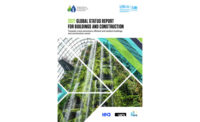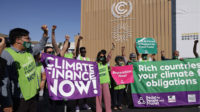Energy codes and building standards are essential to achieving greenhouse-gas-reduction targets and improving communities’ resilience to the impacts of climate change. That was the message delivered in a pair of sessions held in-person and virtually on Friday at the UN Climate Change Conference (COP26) in Glasgow, Scotland (RECORD attended virtually).
A presentation by the International Code Council (ICC)’s vice-president of innovation, Ryan Colker, spotlit a startling disconnect between countries’ aspirations to reduce building-sector emissions and the implementation of codes to do it. Although nearly three quarters of the climate commitments that countries submitted in advance of COP26 cite buildings as a priority for their emissions-reduction targets, only 20 percent of these so-called nationally determined contributions include building energy codes as a strategy. Conveying the missed opportunity with examples and projections, Colker called on “all governments to adopt and enforce building codes aligned with domestic and international goals.”
The building sector is the low-hanging fruit of emissions reduction, according to a 2016 study by the World Resources Institute, with the potential to mitigate 6 gigatonnes (Gt) of carbon dioxide equivalents per year by 2030, about 5.5 Gt of which count as low cost. (By comparison, the mitigation potential of the second lowest–hanging sector, agriculture, totals about 4.4 Gt across all cost categories, with less than 1.5 Gt in low-cost savings.) Cited in a recent ICC report that Colker presented, the U.S. Department of Energy estimates that if progressively improved International Energy Conservation Code models for residential and commercial buildings were consistently implemented from 2010 to 2040, they would save $138 billion in energy costs and 900 million tonnes in avoided greenhouse gas emissions—equivalent to the annual emissions of 195 million passenger vehicles, 227 coal power plants, or 108 million homes.
As of September this year, only 80 countries had implemented building energy codes—mandatory or voluntary, national or subnational—and of these, only 43 had implemented nationwide mandatory codes for both residential and non-residential buildings. Mapping code jurisdictions onto UN population growth projections reveals that 82 percent of global population growth by 2030 will occur in countries without mandatory building energy codes (primarily in the Global South). “If you don’t have building energy codes underpinning that ongoing development, you’re losing opportunities to reduce greenhouse gas emissions,” Colker said.
The Caribbean region has successfully adapted the International Energy Conservation Code to create the CARICOM Regional Energy Efficiency Building Code. In a recorded interview presented in the conference session, Verne Emmanuel, vice-chair of the new standard’s development committee, offered that code as a model for other tropical countries wanting to implement energy standards. “Whether they be in Africa, the Pacific, or places on the same lateral, they would have something which has already been properly peer reviewed and is fit for purpose in a similar geography and climate,” he said.
Emissions reduction is one side of the response to global heating. Adaptation, the focus of a COP26 panel discussion hosted by the Global Resiliency Dialogue (GRD)—an international forum of building code developers and research organizations—is the other; and here, again, codes have a major role to play. The impacts of climate emergencies are increasingly exceeding the conditions for which the built environment was designed. However, a survey conducted by the GRD found that the flood maps, wind maps, and temperature ranges underlying building codes in nearly all countries still rely on historical data. “That is very quickly becoming a lousy assumption,” said catastrophic-risk-and-resilience expert Alice Hill in the panel session. “We need to find ways—as this group has been focused on—to address deeper droughts, stronger storms, more powerful rainfall, and greater heat in our building codes so that communities can reduce their damage from these events, and continue to thrive.”
The GRD’s most recent report, released in the run-up to COP, is based on a global survey of regulators, design professionals, builders, climate scientists, researchers, standards organizations, and the insurance industry. It provides a definition of climate resilience in the context of building regulation, and analyzes comparative findings about the pathways for incorporating changing climate risks in building codes. Through a program of collaborative research, GRD is now developing guidelines to help code jurisdictions around the world transition from historical to predictive climate data—in other words, from the holocene epoch to the anthropocene. A draft is expected in mid-2022.



